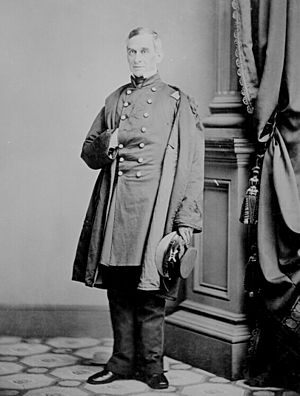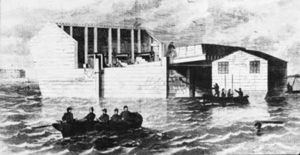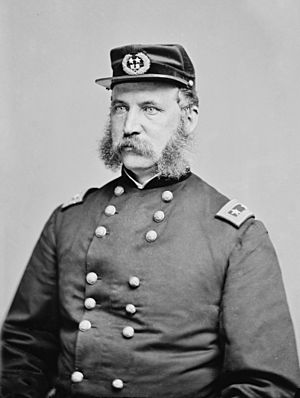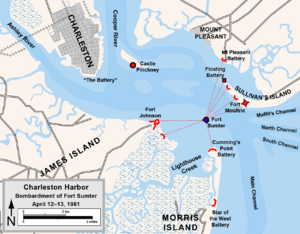Floating Battery of Charleston Harbor facts for kids
The Floating Battery of Charleston Harbor was a special kind of ironclad ship built by the Confederacy in early 1861. This was just a few months before the American Civil War began. People in Charleston at the time thought it was amazing. It was also a very important naval artillery platform. This battery helped attack Fort Sumter on April 12 and 13, 1861. This made it the first floating battery to be used in a battle during the Civil War.
Contents
Why It Was Built
After Abraham Lincoln was elected president on November 6, 1860, many people in Charleston, South Carolina wanted to leave the United States. Tensions grew between the local citizens and the U.S. Army soldiers stationed around Charleston Harbor.
On November 8, Colonel John L. Gardner, a federal commander, upset Charlestonians. He tried to move all the small-arms ammunition from the Charleston Arsenal. Gardner returned the ammunition to calm the crowd. Even so, he was later removed from his command. Governor Francis Wilkinson Pickens ordered South Carolina State troops to guard the arsenal.
The new U.S. Army commander, Major Robert Anderson, moved most of his troops to Fort Moultrie. But he found this fort hard to defend. Sand dunes were almost as tall as the fort walls on the land side. Nearby houses also stood taller than the fort, giving good spots for enemy shooters.
After South Carolina left the Union on December 20, Anderson decided to move his forces. He planned to evacuate across the harbor to Fort Sumter. On the morning of December 27, state troops sounded alarms. They found that Anderson's soldiers had left Fort Moultrie the night before. The soldiers had also made the cannons unusable and burned their carriages.
This made the people of Charleston very angry. They felt betrayed by the evacuation and destruction. Governor Pickens ordered that all other federal positions, except Fort Sumter, be taken over. State troops quickly captured Fort Moultrie (taking 56 cannons), Fort Johnson, and the Morris Island Battery. On December 27, about 150 men also took over Castle Pinckney, capturing 24 cannons without a fight. On December 30, the federal arsenal was captured. The militia took more than 22,000 weapons from it.
The Confederates quickly fixed the cannons and built new carriages. They also made Fort Moultrie stronger. Many new batteries and defense spots were built around Charleston harbor. These were armed with the captured weapons. The Confederates wanted a strong artillery position. So, they decided to build floating batteries. The French Navy had used floating batteries successfully in the Battle of Kinburn (1855). They used them to destroy Russian forts during the Crimean War.
How It Was Made
The floating battery was built on the waterfront in Charleston, South Carolina. It was in plain sight of the Union forces at Fort Sumter. Construction began in January 1861. Lieutenant John R. Hamilton, a former U.S. Navy officer, led the project.
The battery was made from pine logs, each 12 inches (305 mm) thick. It was strengthened with palmetto logs at the front. The outside of the ship was covered with two layers of railroad iron placed vertically. It also had four layers of boiler iron placed horizontally. The battery was about 25 feet wide and 100 feet long.
The huge front of the battery looked like a peaked barn. People even called it "the barn." On this barn-like front were four evenly spaced windows, called casemate windows. These were for the naval guns to fire through. The battery had two 42-pound and two 32-pound naval cannons. A drawing by a Confederate officer shows three of these guns. To balance the heavy front and cannons, the back of the ship had 6-foot-thick sandbag walls. The gunpowder was stored below the sandbags. Cannonballs were kept behind the guns in covered bins under the deck.
Behind the battery, on its own separate raft, was a small floating hospital. A drawing from Frank Leslie's Illustrated Newspaper on March 30, 1861, shows the hospital inside. It seems to have at least eight hospital beds and two operating tables. People could get in through a steep staircase from a hatch in the roof. A wooden door on the side near the water allowed entry and exit. Two glass windows on the other side let in light. Windows in the roof also provided light and air.
People's Reactions
Captain John G. Foster, a Union Army engineer at Fort Sumter, watched the battery being built. He sent reports to his commanders. Foster didn't think much of the battery at first. He wrote, "...I think it can be destroyed by our fire before it has time to do much damage..." A few days later, he added, "...I do not think this floating battery will prove very formidable..."
However, his commander, Major Robert Anderson, was worried enough to ask Washington for specific instructions. He was told that if he believed the battery was moving to attack immediately, he could fire on it. But if it was just being moved to a new position, he should wait.
Some of the Confederate crew members were also worried about the battery. They feared it might tip over and started calling it "the slaughter pen." Union soldiers jokingly called it "the raft."
Despite cold weather, crowds gathered on the Charleston waterfront on March 15 to celebrate the finished battery. A seven-gun salute was fired to honor the seven states that had already left the Union. After a pause, another gun was fired for Arkansas, which was planning to secede.
People in the North were also very interested in the floating battery. The New York Herald newspaper invited readers to their offices to see a palmetto log, like those used in the battery. The Herald also reported that another log was brought North to sell to showman P. T. Barnum. But Barnum refused to pay the $150 asking price.
The Attack on Fort Sumter
Between April 9 and 10, the floating battery was towed into place. It was positioned near the western end of Sullivan's Island, South Carolina. This was done by order of Brigadier General P. G. T. Beauregard. Members of Company D of the South Carolina Artillery Battalion manned the battery. Capt. Hamilton commanded them.
On April 12, Hamilton's floating battery began firing on Union army forces inside Fort Sumter. This artillery attack lasted on and off for 34 hours.
Fort Sumter's cannons hit the battery several times. According to one report, the guns that fired on the battery were 10 32-pounders. By midday, Fort Sumter ran low on ammunition. This forced the Union troops to use only two guns against the batteries on Sullivan's Island.
The floating battery was hit very often by cannonballs. One shot went through the iron covering and wood at the corner between the front and the roof, wounding one man. Other 32-pounder balls did not go through the front or roof. They bounced off because the surfaces were angled to deflect shots.
The damage to the battery was considered minor. When Maj. Anderson surrendered Fort Sumter, the Confederates and the crew of Hamilton's floating battery were victorious. Newspapers and magazines quickly shared details of the battle. Harper's Weekly reported: "On Friday, 12th, at 27 minutes past 4 A. M., General Beauregard... opened fire upon Fort Sumter. Forts Johnson and Moultrie, the iron battery at Cumming's Point, and the Stevens Floating Battery, kept up an active cannonade during the entire day..."
Beauregard praised Capt. Hamilton in his battle report on April 27, 1861. He mentioned Hamilton "in the highest terms of praise" for commanding the floating battery.
What Happened Next
After Fort Sumter surrendered, reports and 22 photographs were sent to LeRoy Pope Walker, the Confederate States Secretary of War. These showed the condition of Forts Sumter, Moultrie, and the floating battery.
What happened to the battery after this is not entirely clear. A United States Coast Survey map from 1863 shows the battery anchored in the harbor. It was located between Middle Ground and Fort Johnson. However, maps made in 1865 do not show the battery anymore.
It seems the Confederates eventually removed the iron from the battery. They likely used this iron to build a new, movable ironclad ship. There is also some evidence that the dismantled battery broke apart during a storm in late 1863. One person serving on Morris Island wrote that they were short on fuel. Then, after a storm, they found logs on the beach that supposedly came from the battery.
In 1865, a visitor to Charleston described the harbor entrance. They said, "... Just beyond the ruin (of Ft. Sumter) at the left, lies the wreck of the famous old floating battery ... A portion of one of its sides, with four portholes visible, still remains above the water. ..."










